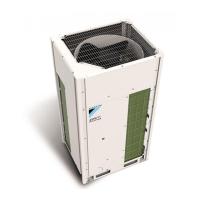25 English
10. Air tight test and vacuum drying
• #HVGTƂPKUJGFRKRKPIYQTMECTT[QWVCKTVKIJVVGUVCPFXCEWWOFT[KPI
NOTE
• Always use nitrogen gas for the air tightness test.
• Absolutely do not open the stop valve until the main power circuit
insulation measurement has been completed. (Measuring after the
stop valve is opened will cause the insulation value to drop.)
0GGFGFVQQNU
Gauge manifold
• To prevent entry of any impurities and insure
UWHƂEKGPVRTGUUWTGTGUKUVCPEGCNYC[UWUGVJG
special tools dedicated for R410A.
• Use charge hose that have pushing stick for con-
necting to service port of stop valves.
Charge hose
Valve
Vacuum pump
• The vacuum pump for vacuum drying should be
able to lower the pressure to 500 microns(66.5 Pa).
• 6CMGECTGVJGRWORQKNPGXGTƃQYDCEMYCTFKPVQ
the refrigerant pipe during the pump stops.
6JGU[UVGOHQTCKTVKIJVVGUVCPFXCEWWOFT[KPI
• 4GHGTTKPIVQVJGƂIWTGDGNQYEQPPGEVCPKVTQIGPVCPMTGHTKIGTCPV
tank, and a vacuum pump to the outdoor unit.
The refrigerant tank and the charge hose connection to service port
QHCNNXCNXGUKPVJGƂIWTGDGNQYCTGPGGFGFKP
%JCTIKPITGHTKIGTCPVQPRCIG|
1
2 3
4
5
6
A
B
C
9
10
10
11
13
12
14
15
7
8
1 Gauge manifold
2 Nitrogen
3 Measuring instrument
4 Refrigerant R410A tank (siphon system)
5 Vacuum pump
6 Charge hose
7 High/low pressure gas pipe stop valve
8 Suction gas pipe stop valve
9 Liquid pipe stop valve
10 Outdoor unit
11 To Branch Selector unit (indoor unit)
12 Valve
13 Field piping
14 )CUƃQY
15 Stop valve service port
A Valve A
B Valve B
C Valve C
NOTE
• The air-tightness test and vacuum drying should be done using the
service ports of suction gas pipe, high/low pressure gas pipe and
NKSWKFRKRGUVQRXCNXG5GGVJG=4#?.CDGNCVVCEJGFVQVJGHTQPV
panel of the outdoor unit for details on the location of the service
RQTVUGGVJGƂIWTGDGNQY
=4#?.CDGN
• 5GG/GVJQFHQTCFFKPITGHTKIGTCPVQPRCIG|HQTFGVCKNUQP
handling the stop valve.
• The refrigerant charge port is connected to unit pipe. When
shipped, the unit contains the refrigerant, so use caution when at-
taching the charge hose.
#KTVKIJVVGUV
Pressurize the suction gas pipe, high/low pressure gas pipe and liquid
RKRGHTQOVJGUGTXKEGRQTVUQHGCEJUVQRXCNXGVQRUK|/2CFQ
PQVRTGUUWTK\GOQTGVJCPRUK|/2C+HVJGRTGUUWTGFQGUPQV
drop within 24 hours, the system passes the test.
If there is a pressure drop, check for leaks, make repairs and perform
the air tight test again.
8CEWWOFT[KPI
Evacuate the system from the suction gas pipe, high/low pressure gas
pipe and liquid pipe stop valve service ports by using a vacuum pump
for more than 2 hours and bring the system to 500 microns (66.5 Pa)
or less. After keeping the system under that condition for more than
1 hour, check if the vacuum gauge rises or not. If it rises, the system
may either contain moisture inside or have leaks.
NOTE
During the rainy season, moisture might enter the piping. If
working during a rainy season and the work takes long enough
for condensation to form inside the pipes, take the following
precautions:
After evacuating the system for 2 hours, pressurize the system to
375,000 microns (0.05 MPa) (vacuum break) with nitrogen gas and
evacuate the system again using the vacuum pump for 1 hour to 500
microns (66.5 Pa) or less (vacuum drying).
If the system cannot be evacuated to 500 microns (66.5 Pa) within
|JQWTUTGRGCVVJGQRGTCVKQPQHXCEWWODTGCMCPFXCEWWOFT[KPI
6JGPCHVGTNGCXKPIVJGU[UVGOKPCXCEWWOHQTJQWTEQPƂTOVJCVVJG
vacuum gauge does not rise.
B(1B0DLQB959B,0LQGG

